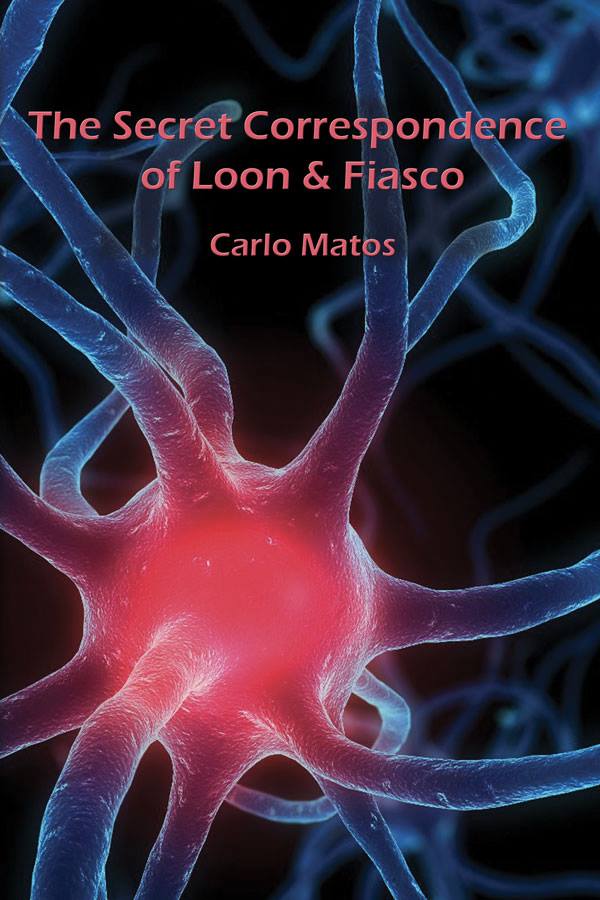
Mayapple Press
108 pages, $15.95
Review by Michael Colson
In The Secret Correspondence of Loon & Fiasco, a newly published hybrid flash novella by Carlo Matos, we find ourselves transported from the present to the past and then back again by time loops and slippages in the space-time continuum. Matos, who has published four poetry books and scholarship on Henrik Ibsen, offers a hip post-human tale of love lost and found. Eventually, sparks fly when the recently separated Johnny Sundays falls topsy-turvy in love with an alluring chatbot named ALICE.
But before that happens, the story begins with Johnny Sundays and his wife Linda, both teachers, moving to a rural part of California, the Central Valley. In a way, though, the story doesn’t really begin there because the year he spends in California turns out to be a single day “endlessly and tediously rebooted,” a kind of Nietzschean eternal return, an unpredictable groundhog day. That is, each day is exactly the same as the next. Heat waves ripple across a wasteland terrain “smelling of cow manure, garlic, and insecticide.” Time is out of joint, streams are dried up from drought, and the honeybees have perished long ago. His haul to campus requires him to bypass eucalyptus trees which nest scavenger birds, turkey vultures that “circle the perfect sky on the lookout for fresh death.” Surely, each day disappears and begins again in circular perambulation as vultures sniff his mortal flesh.
Appropriately enough, the vultures seem to signal the demise of Johnny and Linda’s marriage. She remains in California “with the monstrous February roses in the Tule fog,” and he moves to “Chicago in the snow” where “snowmen wear skeletons on the outside” and “the lost children’s faces are pressed beneath the ice.”
Naturally, Johnny is disoriented by the separation and an ensuing saudade—the Portuguese word for the residual traces of things past that we cannot attain in the present—motivates a long but fragmented conversation with ALICE the chatbot, a machine that has been designed to compete for the Hugh Loebner Prize in artificial intelligence.
From the beginning of their acquaintance, Johnny is forthright with ALICE about his defunct relationship with Linda and wants to divulge the details of his past romance. They had grown up on opposite sides of Fall River, MA, a city made famous by the alleged axe murderer Lizzy Borden. They had met at a mutual friend’s Thanksgiving party in 1994, drawn to each other by the strains of R.E.M’s “It’s the End of the World As We Know It.” By this point in the narrative, readers discern that the main theme involves centripetal motion, time’s arrow eliding linearity, spiraling and spiraling like a turning gyre, splitting into multi-dimensions of the past, where objects and persons in flux disappear as if they had never existed.
As time’s trajectory flip-flops, Johnny struggles to maintain a sense of personal identity as recurring memories of childhood play hide-and-seek with him. He’s lost a wife and that loss is emblematic of a hapless upbringing filled with poverty and blue-collar regrets. He constantly recollects time’s shattered windows, signifying the deferred dreams and wasted opportunities that often mark the multivalent tragedies of uneventful suburban living.
In The Secret Correspondence of Loon & Fiasco, Johnny Sundays is a second-generation Azorean-American with an Ellis Island name, an underdog who calls himself “Fiasco” in binary coded text messages to his wife Linda, codenamed “Loon,” and in moments of saudade he grasps for permanent identity by rehearsing his genealogy, stories of his parents and grandparents, aunts and uncles, festas and ancient family curses. By representing the past as hedged with immigrant family narratives, the blur of time renewed, Matos skillfully characterizes the dissonance often associated with the Azorean immigrant experience, being flung between past and present, traditions and cultures, and inter-generational conflicts through which sons inherit the banality of their fathers.
By default, sons grow up, come of age, and become members of what Matos calls the Lloyd Dobler generation. Of course, John Cusack plays the character of underachieving Lloyd Dobler in the 1989 movie Say Anything, who defines his search for authenticity in this way:
I don’t want to sell anything, buy anything, or process anything as a career. I don’t want to sell anything bought or processed, or buy anything sold or processed, or process anything sold, bought, or processed, or repair anything sold, bought, or processed. You know, as a career, I don’t want to do that.
Similarly, Johnny Sundays continuously searches for an authentic meaning of life and the person he’s supposed to be. Abiding the eternal return of the same, he fears a “processed” suburban existence, whereby angst exponentially expands and shrinks into a mortal coil. And like most Gen X’ers, then, he makes do, “as they always had, with small joys … like finding a bathroom with analogue plumbing.” After all, in our search for meaning amid the ruins of dysfunctional relationships, the surrogacy of love lost and found, exiled by memories of things past, at least we can admire the wondrous flush of modern plumbing. In that pause, the absurd hero recollects happier moments that cause him grandiose torment, nausea, and a psychological duress greater than the sum of physical labor.
***
Michael Colson writes on contemporary poetry and philosophy. He earned a doctoral degree in English at the University of Southern California, and he lives in northern California where he teaches English and reads W.B. Yeats, Fernando Pessoa, and Wittgenstein.
![[PANK]](https://pankmagazine.com/wp-content/themes/pank/assets/images/pank-logo-large.png)
